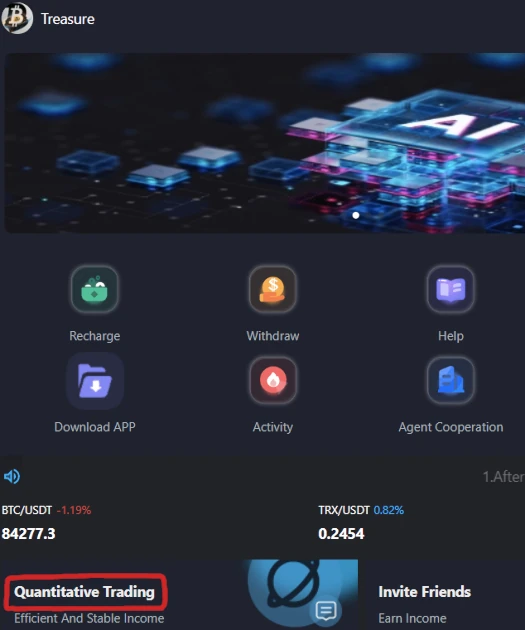Treasure Review: Quantitative trading “click a button” Ponzi
 Treasure fails to provide ownership or executive information on its website.
Treasure fails to provide ownership or executive information on its website.
Treasure operates from two known website domains:
- nk116.com – privately registered on February 26th, 2025
- asctr.com – registered with bogus details on February 20th, 2025
Of note is Treasure’s “asctr.com” domain being registered through the Chinese registrar Alibaba (Singapore).
It should also be noted that, until recently, Treasure’s “nk116.com” domain was being used to run Nuclear AI. Nuclear AI is an already-collapsed “click a button” Ponzi scheme.
Treasure has already attracted the attention of financial regulators. The Central Bank of Russia issued a Treasure pyramid fraud warning on April 14th, 2025.
As always, if an MLM company is not openly upfront about who is running or owns it, think long and hard about joining and/or handing over any money.
Treasure’s Products
Treasure has no retailable products or services.
Affiliates are only able to market Treasure affiliate membership itself.
Treasure’s Compensation Plan
Treasure affiliates invest tether (USDT). This is done on the promise of advertised returns.
Specific investment tiers aren’t disclosed without downline Treasure’s app.
Treasure pays referral commissions on invested USDT down three levels of recruitment (unilevel):

- level 1 (personally recruited affiliates) – 10%
- level 2 – 2%
- level 3 – 1%
Joining Treasure
Treasure is yet another “click a button” app Ponzi scheme.
Treasure’s “click a button” Ponzi ruse is quantitative trading:

The presented ruse is Treasure affiliates log in and click a button (the more invested the more the button needs to be clicked).
Clicking the button purportedly generates revenue via quantitative trading, which for some reason Treasure shares a percentage of with affiliate investors.
If that makes no sense it’s because it doesn’t. Randoms clicking a button in an app doesn’t trigger quantitative trading.
In reality clicking a button inside Treasure’s app does nothing. All Treasure does is recycle newly invested funds to pay earlier investors.
Treasure is part of a group of “click a button” app Ponzis that have emerged since late 2021.
Examples of already collapsed “click a button” app Ponzis using the same quantitative trading ruse are Q-Research, AGI AI and DSOA.
Since 2021 BehindMLM has documented hundreds of “click a button” app Ponzis. Most of them last a few weeks to a few months before collapsing.
“Click a button” app Ponzis disappear by disabling both their websites and app. This tends to happen without notice, leaving the majority of investors with a loss (inevitable Ponzi math).
In the lead up to a collapse, “click a button” Ponzi investors also tend to find their accounts locked. This typically coincides with a withdrawal request.
As part of a collapse, “click a button” Ponzi scammers often initiate recovery scams. This sees the scammers demand investors pay a fee to access funds and/or re enable withdrawals.
If any payments are made withdrawals remain disabled or the scammers cease communication.
Organized crime interests from China operate scam factories behind “click a button” Ponzis from south-east Asian countries.
In September 2024, the US Department of Treasury sanctioned Cambodian politician Ly Yong Phat over ties to Chinese human trafficking scam factories.
Through various companies he owns, Phat is alleged to shelter Chinese scammers operating out of Cambodia.
Myanmar claims to have deported over 50,000 Chinese scam factory scammers since October 2023. With “click a button” app scams continuing to feature on BehindMLM though, it is clearly not enough.
In late January 2025, Chinese ministry representatives visited Thailand. The stated aim of the visit was to tackle organized Chinese crime gangs operating from Myanmar.
In early February 2025, Thailand announced it had cut power, internet access and petrol supplies to Chinese scam factories operating across its border with Myanmar.
As of February 20th, Thai and Chinese authorities claim ten thousand trafficked hostages had been freed from Myanmar compounds.
Also on February 20th, five Chinese crime bosses were nabbed in a wider raid of four hundred and fifty arrests in the Philippines.
On March 19th it was reported that, despite the recent raids and arrests, “up to 100,000 people” are still working in Chinese Myanmar scam factories.
Regardless of which country they operate from, ultimately the same group of Chinese scammers are believed to be behind the “click a button” app Ponzi plague.
Update 28th April 2025 – Treasure has begun to collapse. As at the time of this update Treasure’s “nk116.com” domain has been disabled.


I am shocked that people would click often just to become clickbaits!